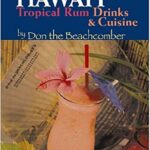Hawaii: A Paradise for Rum Making
One of the islands where rum is becoming increasingly popular is Hawaii. It has a terroir ideal for rum distillation, modern distilling methods, and a long history in the sugarcane industry.
Hawaii has established itself as an emerging market for rum production thanks to local intrepid distillers who want to reconnect with the islands’ cultural heritage. Despite its small size, Hawaiian rum producers have concentrated on preserving local sugarcane varietals. The result has been a vibrant collection of spirits with a distinctly Hawaiian flavor.
A Sip of History: Hawaii’s Sugarcane Plantations
Since the middle of the nineteenth century, Hawaii has been producing sugarcane spirits. Its distinctive feature is that it thrives on rich, volcanic soil that receives nourishment from Mount Wai’ale’ale’s pure water.
Early Polynesians brought 27 canoe plants to the islands between 400 and 600 CE. Sugarcane, which is called ko in Hawaiian, was one of them. This happened before Christopher Columbus came to the New World and introduced the crop to Europe. Islanders used to value the plant holistically and medicinally, employing its sweet juice to sweeten bitter medicines, improve the health of their gums and teeth, and cure wounds. They also relied on its leaves for thatching and religious rituals.
By the 1800s, the islands used to have many sugarcane farms, which benefited their expanding economy. Still, Hawaii’s locals were more concerned with exporting sugar than making rum. In 1835, a group of New England friends established the first prosperous sugarcane plantation in Koloa, Kauai, by the name of Ladd and Company. The advent of this company in Hawaii was the beginning of economic prosperity and transition. By the late 1840s, Hawaii exported silk, beef, coffee, and molasses.
For centuries, the sugar industry was Hawaii’s calling card, made even more profitable by the reciprocity agreement signed by the US and the Kingdom of Hawaii in 1875, which allowed the sugar trade to flourish. Hawaii’s sugarcane plantations changed the crop from a cultural pillar for the islands’ indigenous people to an economic boon for the colonizers. The sugar industry exploded, and Hawaii’s economy became inextricably linked to sugarcane. Plantations sprouted up all over the islands, shipping the majority of their produce to the mainland United States.
Built on the backs of immigrant labor and land leasing, the rules changed in 1959 when Hawaii became a state. As the cost of labor went up, plantation owners in Hawaii gave up the sugar business. Later on, that chapter of sugarcane history came to an end when the last sugar mill in Maui closed in 2016. The abundance of native varieties began to dwindle over time. Sugarcane is no longer used to make sugar in Hawaii and is rarely grown on local farms.
However, today, there are sugar plantations that only grow the varieties that allow them to increase their profits. In fact, a small group of farmers and business owners held on to the hope of bringing back the native plant and embracing a lost part of Hawaii’s culture. Consequently, four innovative distilleries emerged:
What Makes Hawaii an Ideal Playground for Rum Distillers?
Hawaii’s ideal growing environment for sugarcane may be the foundation of the islands’ eventual distilling skills, but other factors also make it the ideal playground for distillers. Because of its climate, Hawaii is an excellent place to grow sugarcane and thus produce rum. The volcanic soil, variety of agrotourism, and long history of farming on the islands make them a real gem for making rum.
Since other rum cultures have been around for hundreds of years, many pioneering islands and regions have set up classic flavor profiles based on traditions, rules, and terroir. However, Hawaii’s distillers are taking a more innovative approach to foster the islands’ rum culture.
Hawaii produces more than just white, dark, and gold rums. Spiced and flavored rums, with more grassy freshness and tropical notes, are becoming increasingly popular among cocktail creators and rum aficionados.
Hawaiian rum distilleries promote a hands-on process as, for them, it is critical to make the agricultural side of their operations work for their distilleries. That said, the styles brought out by each distillery are vastly different, and this will be favorable to the development of Hawaii’s rum industry. However, all of them have worked to instill a sense of place in their spirits, and each distillery has dedicated itself to revitalizing Hawaii’s sugarcane heritage.
Although there are still some obstacles to overcome, especially those related to growing the different varieties of sugarcane, these rums are a true reflection of Hawaii as a whole, providing sippers with a taste of the islands that has not previously been available and, of course, honoring the history of native sugarcane.





